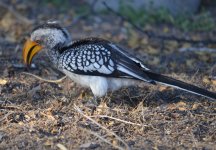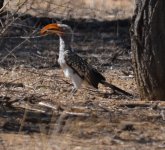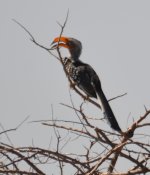Both those species have a white outertail. I think you may be confused by your own photos: in your Damara hornbill photo 4348, the outermost feather happens to be lying slightly inboard of the adjacent feather, giving the effect of a dark outertail - even though you can see clearly the shaft of the largely-white (actual) outermost feather (in a closed tail, seen from underneath, it's only the outermost pair of feathers that comprise almost everything that's visible). Presumably the same effect is also happening in your Damara hornbill photo 0523, even though in this case individual feathers are not visible.
The largely-white outermost tail-feathers of Damara hornbill are shown here:
Macaulay Library ML614527037; © Morten Winther Dahl; Oshikoto, Namibia

macaulaylibrary.org








